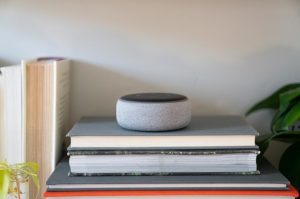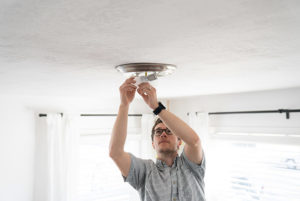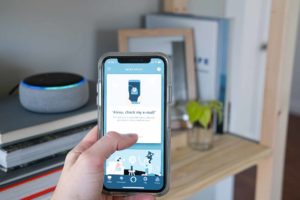The only downside is that, to enjoy a smart home, you have to set it up. Sound intimidating? Don’t worry. We’re here to walk you through it. Okay, ready? Let’s move on to step two. Let’s break it down. A smart home hub acts as a conduit to connect all your devices to one source. Your garden-variety smart hubs usually won’t have many extra features. Classic example of this: the Samsung SmartThings hub. SmartThings doesn’t have built-in voice control, but it is compatible with a variety of gadgets. To throw another wrinkle in things, while most hubs are physical devices, you can also use a protocol like IFTTT. The If This Then That software lets you set up cause-and-effect chains on your phone without connecting hardware. If you need help to make a decision, check out our rankings for the best smart hubs. Once you have a smart hub, you’ll need to add it to your network to get started. Follow the instructions provided with the product to complete setup. If your smart hub has a voice assistant, it’s best to try out a few commands before installing any other equipment. The plug’s app should guide you in connecting to the Wi-Fi. If you have a smart speaker, you can further connect the plug to the speaker for voice control: “Alexa, turn off smart plug!” Just an FYI: smart outlets are a little different than plugs, but you set them up similarly. You don’t have to hardwire a smart outlet into your home; most of them plug over an existing outlet. Once your lights are in, you can have a lot of fun. Turn them on and off from another room or even another state. Some lights also change colors or flicker in time to music. A lot of DIY systems, like SimpliSafe, Abode, and Ring, have peel-and-stick equipment. You’ll never have to use a hammer or screws, and if you’re renting or selling your place, you can remove the equipment without damaging the walls. But there’s still a lot of home security equipment that needs to be mounted or drilled into place. If you’re not handy, you might want to reach out to a friend or contract an expert. When it comes to installing security equipment, you may opt for a few security cameras, or you might choose to get a full security system. You could even just get a door lock, a motion detector, or open/close sensors. Whatever you need, go ahead and add it to your smart home suite. If you don’t want to hunt everything down separately, lots of security brands offer starter kits. Check out Ring or SimpliSafe for a good starter kit example. Other home appliances and items you can smarten up include the following:
Mattresses Blankets Pillows Garage doors Flower pots Canisters/jars Dishwashers Ovens Toasters Smoke detectors CO detectors Thermostats Washers Dryers Vacuums Sweepers Mops Pet feeders Showerheads
So what smart devices do you absolutely need? First, if you have any special needs or disabilities, cater to those first. For instance, if you’re bound to the ground floor but have family members on the top floor, invest in smart speakers that can be used as intercoms. Or if you’ve got latchkey kids, get smart door locks and garage door openers that they can control from their phones. But apart from that, after plugs, lights, and security, we’d prioritize comfort and convenience. Get that voice-controlled smart thermostat! Buy a video doorbell so you can see who’s there without walking downstairs, or invest in a robot vacuum. We think new tech should be both useful and fun, so invest in the smart home gadgets that appeal to you. If you’re still not sure where to start, pick one room to trick out with smart home technology. Then go through the rest of the house by room.
Internet Smart hub Plugs Lights Security Everything else
If the thought of doing this all on your own overwhelms you, you can start with the internet and then jump to Vivint, our number one smart home and security recommendation. Vivint will professionally install an entire smart home for you. The only downside is that you’ll be limited to Vivint-approved equipment and have to pay a monthly fee. There are also other options for a smart home setup, like the Apple HomePod. This speaker also functions as a hub that runs through Apple HomeKit.



title: “How To Set Up Your Smart Home Learn The First Steps” ShowToc: true date: “2023-01-08” author: “Dorothy Brady”
Optus Mobile Review ALDI Mobile Review Amaysim Mobile Review Belong Mobile Review Circles.Life Review Vodafone Mobile Review Woolworths Mobile Review Felix Mobile Review Best iPhone Plans Best Family Mobile Plans Best Budget Smartphones Best Prepaid Plans Best SIM-Only Plans Best Plans For Kids And Teens Best Cheap Mobile Plans Telstra vs Optus Mobile Optus NBN Review Belong NBN Review Vodafone NBN Review Superloop NBN Review Aussie BB NBN Review iiNet NBN Review MyRepublic NBN Review TPG NBN Review Best NBN Satellite Plans Best NBN Alternatives Best NBN Providers Best Home Wireless Plans What is a Good NBN Speed? Test NBN Speed How to speed up your internet Optus vs Telstra Broadband ExpressVPN Review CyberGhost VPN Review NordVPN Review PureVPN Review Norton Secure VPN Review IPVanish VPN Review Windscribe VPN Review Hotspot Shield VPN Review Best cheap VPN services Best VPN for streaming Best VPNs for gaming What is a VPN? VPNs for ad-blocking The only downside is that, to enjoy a smart home, you have to set it up. Sound intimidating? Don’t worry. We’re here to walk you through it. Okay, ready? Let’s move on to step two. Let’s break it down. A smart home hub acts as a conduit to connect all your devices to one source. Your garden-variety smart hubs usually won’t have many extra features. Classic examples of this: the Wink hub or Samsung SmartThings hub. Wink and SmartThings don’t have built-in voice control, but they’re compatible with a variety of gadgets. To throw another wrinkle in things, while most hubs are physical devices, you can also use a protocol like IFTTT. The If This Then That software lets you set up cause-and-effect chains on your phone without connecting hardware. If you need help to make a decision, check out our rankings for the best smart hubs. Once you have a smart hub, you’ll need to add it to your network to get started. Follow the instructions provided with the product to complete setup. If your smart hub has a voice assistant, it’s best to try out a few commands before installing any other equipment. The plug’s app should guide you in connecting to the Wi-Fi. If you have a smart speaker, you can further connect the plug to the speaker for voice control: “Alexa, turn off smart plug!” Just an FYI: smart outlets are a little different than plugs, but you set them up similarly. You don’t have to hardwire a smart outlet into your home; most of them plug over an existing outlet. Once your lights are in, you can have a lot of fun. Turn them on and off from another room or even another state. Some lights also change colors or flicker in time to music. A lot of DIY systems have peel-and-stick equipment. You’ll never have to use a hammer or screws, and if you’re renting or selling your place, you can remove the equipment without damaging the walls. But there’s still a lot of home security equipment that needs to be mounted or drilled into place. If you’re not handy, you might want to reach out to a friend or contract an expert. When it comes to installing security equipment, you may opt for a few security cameras, or you might choose to get a full security system. You could even just get a door lock, a motion detector, or open/close sensors. Whatever you need, go ahead and add it to your smart home suite. If you don’t want to hunt everything down separately, lots of security brands offer starter kits. Check out Ring or SimpliSafe for a good starter kit example. Other home appliances and items you can smarten up include the following:
Mattresses Blankets Pillows Garage doors Flower pots Canisters/jars Dishwashers Ovens Toasters Smoke detectors CO detectors Thermostats Washers Dryers Vacuums Sweepers Mops Pet feeders Showerheads
So what smart devices do you absolutely need? First, if you have any special needs or disabilities, cater to those first. For instance, if you’re bound to the ground floor but have family members on the top floor, invest in smart speakers that can be used as intercoms. Or if you’ve got latchkey kids, get smart door locks that they can control from their phones. But apart from that, after plugs, lights, and security, we’d prioritize comfort and convenience. Get that voice-controlled smart thermostat! Buy a video doorbell so you can see who’s there without walking downstairs, or invest in a robot vacuum. We think new tech should be both useful and fun, so invest in the smart home gadgets that appeal to you. If you’re still not sure where to start, pick one room to trick out with smart home technology. Then go through the rest of the house by room.
Internet Smart hub Plugs Lights Security Everything else
If the thought of doing this all on your own overwhelms you, you can start with the internet and then jump to Vivint, our number one smart home and security recommendation. Vivint will professionally install an entire smart home for you. The only downside is that you’ll be limited to Vivint-approved equipment and have to pay a monthly fee. There are also other options for a smart home setup, like the Apple HomePod. This speaker also functions as a hub that runs through Apple HomeKit.


